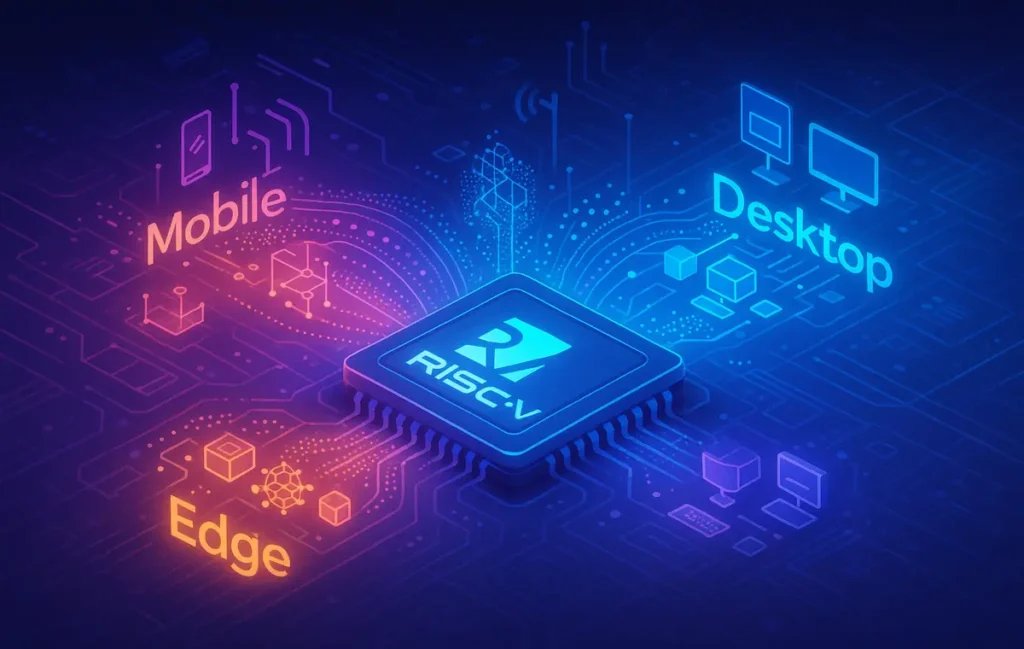🎬 Intro
A few years ago, RISC-V was a curiosity—a research project praised by academics but dismissed by mainstream developers. Fast-forward to 2025, and it has become one of the most closely watched architectures in tech. From powering AI accelerators at the edge to showing up in experimental tablets and gaining CUDA support from Nvidia, RISC-V has shifted from “maybe” to “momentum.”
This post explores RISC-V’s current trajectory across AI edge, mobile, and desktop computing, the roadblocks it faces, and what scenarios might unfold in the years ahead. If you’re a developer, investor, or tech enthusiast, this is your pulse check on the future of compute.
💡 Nerd Tip: Think of RISC-V not as a CPU replacement today but as an extensible canvas—one that companies can mold to their needs in AI, edge, and custom silicon.
🏛️ Historical Context & Why Now
RISC-V began at UC Berkeley as an open instruction set architecture (ISA). Unlike ARM and x86, it is royalty-free and fully extensible. Anyone can design silicon on top of it, without paying licensing fees or dealing with locked-down roadmaps.
For years, it lingered in academia and startups. The turning point came when global pressures—export restrictions, the hunger for AI-specific chips, and the rise of modular chiplets—made a customizable ISA attractive. Companies in China, India, and Europe saw in RISC-V a chance to reduce dependence on ARM and Intel while tailoring chips to their workloads.
The “why now” moment is clear: AI workloads demand specialized instructions. Energy-efficient edge devices need lightweight silicon. Governments want sovereignty in compute. RISC-V answers all three.
For those following AI & future tech predictions for the next decade, RISC-V is no longer theoretical—it’s entering the market at a critical inflection.
🤖 RISC-V at the AI Edge
The AI edge is RISC-V’s strongest beachhead. Devices like smart cameras, industrial sensors, and IoT hubs require low-power, customizable processors that can handle inference close to the data source.
Recent research highlights this. One study demonstrated a chiplet-based RISC-V SoC with modular AI acceleration, allowing companies to add neural engines without redesigning the entire CPU. Others showed how RISC-V designs can achieve sub-10 millisecond inference latency while keeping power under 5W.
The flexibility matters: startups can strip the ISA down for efficiency, then bolt on tensor extensions or DSP cores as needed. This is a stark contrast to ARM-based designs that lock customers into specific feature sets.
Momentum is building: RISC-V International reports dozens of edge AI projects in healthcare wearables, smart agriculture, and industrial robotics. It’s no coincidence that Nvidia announced CUDA support for RISC-V—AI developers want seamless workflows across GPUs and CPUs, and CUDA is the bridge.
💡 Nerd Tip: For edge deployments, prioritize RISC-V platforms with strong community support for ML compilers like TVM and ONNX Runtime. The hardware only matters if the software stack keeps up.
Interestingly, the momentum RISC-V is building in AI workloads has parallels with other industries where compute customization is transforming experiences. Take the AI revolution in gaming, where purpose-built chips and smarter engines are redefining what real-time rendering and adaptive gameplay mean. The lesson is the same: specialized architectures, whether for gaming GPUs or RISC-V edge accelerators, are becoming the new normal.
📱 RISC-V in Mobile & Portable Devices
Mobile has been slower to adopt RISC-V, but 2025 brought a shift. Devices like the PineTab-V, an experimental tablet, put RISC-V silicon in consumer hands. While performance lags behind mainstream ARM chips, the symbolic leap is huge: RISC-V isn’t confined to labs anymore.
The challenge is software. Mobile ecosystems are notoriously sticky. App compatibility, GPU drivers, and power management are deeply optimized for ARM. Developers testing RISC-V on Linux-based devices often report missing features, buggy drivers, or reliance on emulation.
That said, in regions where sovereignty matters—China in particular—RISC-V is making inroads. Domestic handset makers have tested prototypes, betting that open silicon could reduce dependence on foreign licenses. In developing markets, low-cost RISC-V smartphones may emerge as budget alternatives, even if performance trails.
The comparison is stark: ARM delivers a mature, optimized ecosystem, but at licensing cost and limited customization. RISC-V offers freedom and extensibility but requires patience.
💡 Nerd Tip: If you’re experimenting with RISC-V on mobile, focus on developer boards first. Jumping to consumer devices too early can frustrate with ecosystem gaps.
While RISC-V is carving its space in AI edge and mobile, it’s worth remembering that compute innovation doesn’t stop there. Just as open silicon is reshaping chip design, quantum computing breakthroughs are pushing boundaries on the other extreme of the performance spectrum. For developers, following both fields is like watching two futures unfold—one rooted in efficiency and openness, the other in raw quantum leaps.
💻 RISC-V in Desktops & Servers
This is where RISC-V faces its toughest test. Startups like SiFive are designing desktop-class processors, promising performance competitive with mid-range ARM cores. Their AI-focused SoCs hint at a future where RISC-V powers workstations tuned for machine learning.
The headline moment came when Nvidia extended CUDA support to RISC-V. This matters: CUDA is the dominant platform for GPU-accelerated computing. If RISC-V CPUs can run CUDA-based workloads seamlessly, the barrier between ARM, x86, and RISC-V narrows.
Other projects, like Oxmiq’s RISC-V-based GPU initiative led by Raja Koduri, suggest a possible GPU ecosystem around RISC-V. This could create a fully open compute stack—from ISA to GPU acceleration.
But roadblocks remain. Legacy software support is thin. Compilers like LLVM support RISC-V, but performance tuning is immature. Running Windows applications on RISC-V desktops is still science fiction. The desktop will likely remain experimental for several years.
For now, RISC-V desktops are a developer playground. Servers may follow faster—especially in AI inference workloads where custom acceleration trumps legacy app compatibility.
Healthcare is another domain where the low-power, customizable nature of RISC-V is already being tested. Imagine hospital devices or wearables running inference locally rather than streaming sensitive data to the cloud. This aligns perfectly with broader trends in AI in healthcare, where privacy, latency, and reliability matter as much as accuracy. RISC-V gives startups a way to tailor silicon exactly for those requirements.
🧱 Key Barriers
RISC-V’s open nature is both its strength and weakness. The very flexibility that excites startups creates fragmentation. Without standardization, vendors risk building incompatible extensions.
Tooling remains a hurdle. While LLVM, GCC, and QEMU support RISC-V, developers often encounter missing libraries, unstable compilers, and limited debugging tools. Operating systems support basic RISC-V builds, but GPU drivers and middleware lag far behind.
Economic barriers are real too. Designing silicon isn’t cheap. While avoiding ARM royalties saves money long-term, initial design and fabrication costs are steep. For small players, the open ISA doesn’t magically solve funding gaps.
Finally, legacy compatibility haunts adoption. Enterprises hesitate to move away from x86 and ARM ecosystems because of existing software investments. Unless virtualization and translation layers mature, RISC-V will struggle to break into mainstream desktops.
🌍 Outlook & Scenarios
When we zoom out, RISC-V isn’t just a technical milestone—it’s a signal of where computing could head over the next 5–10 years. Our earlier exploration of AI & future tech predictions for the next decade highlighted the shift toward modular, sovereign, and AI-optimized architectures. RISC-V fits that narrative perfectly, suggesting we’re entering an era where open compute stacks are no longer optional but inevitable.
What comes next? Several scenarios stand out:
-
Scenario 1: Edge Champion. RISC-V dominates AI edge devices, carving out a secure position in IoT, wearables, and industrial sensors.
-
Scenario 2: Mobile Challenger. RISC-V gains share in China and emerging markets, offering affordable, sovereign alternatives to ARM-based devices.
-
Scenario 3: Compute Contender. With CUDA support and GPU partnerships, RISC-V evolves into a real competitor in AI servers and specialized desktops.
Acceleration factors include partnerships with hyperscalers, continued CUDA integration, and standardized ISA extensions. News like Meta eyeing Rivos (a RISC-V AI startup) and CUDA’s official support show that momentum is building, even if the road is long.
For investors, RISC-V is less about replacing Intel or ARM tomorrow and more about backing a trend toward open, modular, AI-ready compute. For developers, it’s a call to experiment now, while the ecosystem is still forming.
💡 Nerd Tip: If you’re building for the long term, think hybrid. RISC-V may coexist with ARM and x86 for years. The winners will be those who know how to integrate across all three.
No momentum check would be complete without acknowledging the competitive backdrop. The surge of interest in RISC-V is happening alongside Big Tech’s AI arms race, where companies like Nvidia, Google, and Meta are racing to dominate silicon, software, and platforms. Their involvement—or resistance—will heavily influence whether RISC-V becomes a mainstream force or remains a specialized tool.
🛠️ Developer Ecosystem & Tooling Readiness
One of the biggest questions surrounding RISC-V adoption isn’t just about silicon—it’s about the software stack that makes silicon usable. Developers need compilers, debuggers, profilers, and robust IDE integration to make the architecture viable at scale. While LLVM and GCC now include solid RISC-V backends, performance tuning and advanced optimization support remain inconsistent compared to ARM or x86.
Debugging is still a pain point. Toolchains like GDB have support, but developers often report incomplete features, especially when working with hardware acceleration. Profiling tools—critical for AI workloads—are in their infancy, leaving performance tuning largely experimental. IDEs like Visual Studio Code offer extensions, but integration isn’t as seamless as established ecosystems.
Despite these challenges, progress is steady. The open-source community has been active, and companies like SiFive and GreenWaves are funding ecosystem growth. With Nvidia’s CUDA now extending to RISC-V, more attention is turning to aligning compilers with GPU acceleration pipelines.
💡 Nerd Tip: For developers curious about RISC-V, the best starting point today is emulation via QEMU and contributing patches to LLVM. Early adopters don’t just use the ecosystem—they help shape it.
🌍 Industry & Geopolitical Angle
RISC-V’s rise cannot be separated from the geopolitical shifts in global tech. For decades, compute power was dominated by Western-controlled ISAs like Intel’s x86 and ARM’s licensed cores. But escalating tensions and export restrictions have created a demand for sovereignty in silicon.
China has invested heavily in RISC-V startups, seeing it as a pathway to independence from ARM and x86. India, too, launched national initiatives to support RISC-V processors for both consumer and defense applications. The European Union has funded RISC-V projects under its push for digital sovereignty.
This positioning makes RISC-V more than just a technical curiosity—it’s a strategic hedge. Governments and enterprises want assurance that their compute stacks won’t be blocked by licensing or trade wars. RISC-V offers exactly that: an open ISA immune to unilateral control.
However, geopolitics cuts both ways. While adoption accelerates in China and Europe, some U.S. players remain cautious, fearing fragmentation or reduced ROI in a landscape of competing standards. Whether RISC-V becomes the “third global ISA” will depend as much on politics as on performance.
📊 Benchmarks & Case Studies
Numbers tell stories that theory cannot. Early benchmarks of RISC-V edge devices show promising results. For example, a RISC-V SoC with modular AI acceleration reported inference latency under 8 milliseconds while consuming less than 5 watts—competitive with low-tier ARM alternatives.
In terms of compute efficiency, academic tests suggest RISC-V cores can achieve 15–20% better energy savings than ARM Cortex-M equivalents in certain IoT workloads, though raw performance still trails in high-end tasks.
Case studies are also emerging. One startup in smart agriculture migrated sensor nodes from ARM Cortex chips to RISC-V, reporting a 12% drop in energy consumption and improved ability to customize firmware for machine learning models. In contrast, another fintech startup tested RISC-V desktop prototypes but abandoned the experiment due to limited driver support for GPUs and encryption libraries—showing the technology’s uneven maturity.
The key lesson is that RISC-V shines in custom, low-power workloads today. General-purpose computing will take time, but niche deployments already deliver ROI.
⚠️ Long-Term Risks & Unknowns
While the hype around RISC-V is real, risks remain. The most immediate concern is fragmentation. With so many companies adding custom extensions, there’s a danger of incompatible RISC-V variants emerging, splintering the ecosystem the way early Unix once did.
Software immaturity is another threat. Without robust driver ecosystems, especially for GPUs and memory controllers, RISC-V will struggle to break into desktops and servers. Many developers won’t commit until the toolchain reaches ARM-level polish.
Economic risks matter too. Designing chips, even on an open ISA, costs hundreds of millions. Small startups may underestimate the burn rate, leading to abandoned projects. Meanwhile, large vendors like Intel or AMD could leverage their economies of scale to outcompete RISC-V even if technically inferior.
Finally, adoption uncertainty lingers. Enterprises with decades of investment in x86 and ARM software won’t shift lightly. Unless compatibility layers mature, RISC-V may remain confined to edge AI and sovereign markets.
The opportunity is massive, but the risks remind us: momentum doesn’t guarantee dominance.
Want More Tech Future Insights?
Join our free newsletter and get deep dives on open silicon, AI hardware, and future compute—straight from NerdChips.
No hype, no fluff. Just trend reports and insights for future builders.
🧠 Nerd Verdict
RISC-V is no longer a research novelty. It is establishing itself in AI edge computing, cautiously entering mobile, and preparing—though not yet ready—for desktops and servers. The momentum is undeniable, but the hurdles are real.
In 2025 and beyond, the smart money will back RISC-V not as a replacement but as a complementary force—a platform where customization, sovereignty, and AI-specific acceleration matter most. For readers of NerdChips, the takeaway is clear: watch this space closely. The open silicon movement has just begun, and its ripple effects may reshape the entire compute stack.
❓ FAQ: Nerds Ask, We Answer
💬 Would You Bite?
If you had to bet today, would you invest in RISC-V edge accelerators—or build software ecosystems for RISC-V desktops and mobile devices?
Crafted by NerdChips for developers, creators, and future builders exploring the next frontier of compute.



